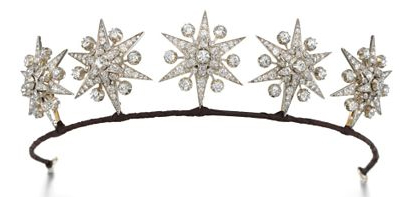I talked to Jovy in the Madison Ave store, and now the pieces I used to pay $600 for are now $4300, and she said the women from Paris are flying over to NYC to buy them because of the exchange rate. So I felt, well, I have my collection of Alexandre Paris haute couture, and that will just have to be it.
BUT
I found one from Hong Kong that was selling for $195 in the original box from the store, and they showed pics of the name, and I know this was a genuine couture piece. It was over. I bought it at an offer price of $180. I wear an Alex barrette or snood every single day. My 50th birthday is coming up in a month. I will love this and wear it A LOT. ;-) I’m going to tell Jovy. Ha! But I have to tell you. This is the first Alex couture piece I’ve seen on ebay in the 5 years I’ve been searching. You may refer to auction #260289856340.
The flower is made of suede with hand-beaded crystals by a French haute couture attelier.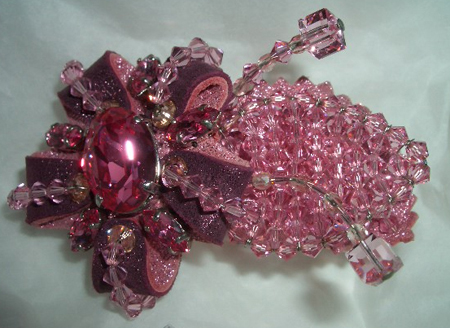
Some Lovely Things on Ebay and Beyond
Portrait of a Lady: This painting of the Parmese School, c. 1775, possibly shows Archduchess Maria Carolina of Austria, Queen of Naples and Sicily (1752-1814) with pearls and ribbons in her hair. It’s oil on cavas, going on sale in London on Sept. 28, est: $3500.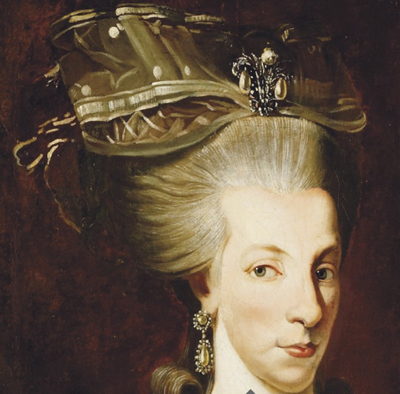
This is one of a pair of art nouveau tortoiseshell hair combs with plique-à-jour enamel flowers and foliate scrolling detail by Braquemond. There is scalloped 18K gold trim, and it is mounted in enamel. These combs formed part of a toilet set for Baron Joseph Vitta, who lived in Paris, and was an important art nouveau patron. c.1900. est: $50,000 – $70,000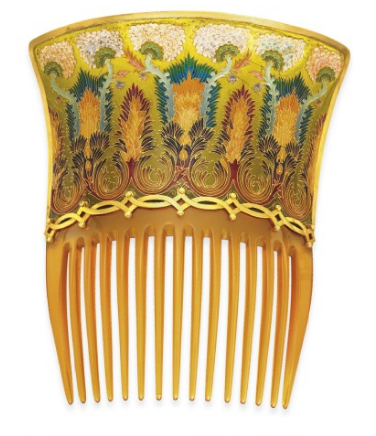
This acrylic-on-paper painting of a nude with blue hair is by Wallase Ting, c. 1929, and is estimated at $9000. I love it.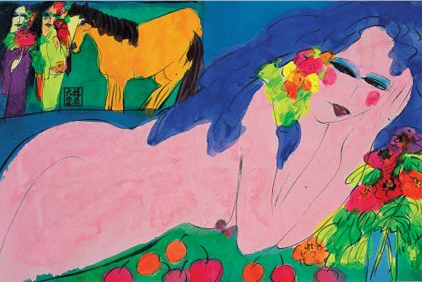
This early 19th-Century silver gilt, diamond and sapphire tiara sold on ebay for $3000 on Sept 19. Congratulations to the winning bidder. It is set with 7-10 carats of natural cabochon sapphires, 3-5 carats of table cut diamonds, and nine large sapphires with a total weight of 15-20 carats.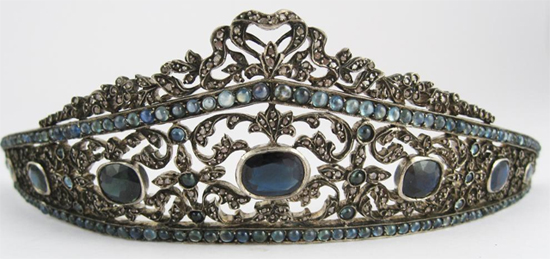
These are two combs from Africa that just caught my eye. I love the expressions of the sculpture on top of the combs.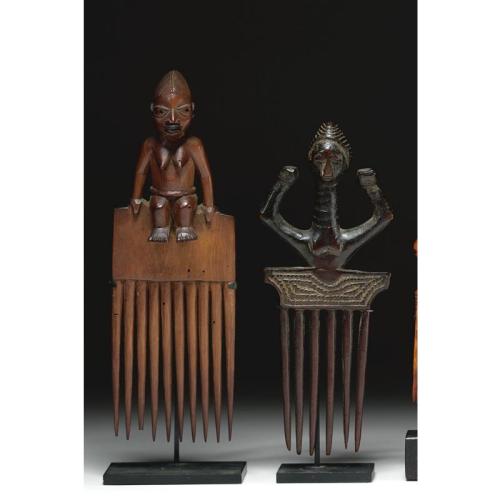
This pair of Edwardian tortoiseshell haircombs with diamonds on top have a curved design, as well as curved tines. They sold on ebay for $1800 on Sept 18 to a live auction floor bidder.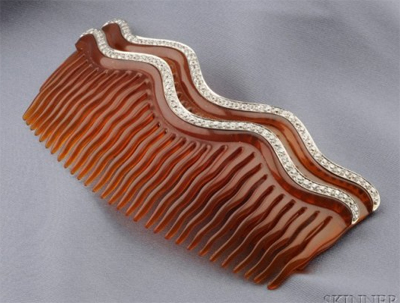
This gorgeous coral diadem with leaves and flowers sold for $500 (great price) on Sept 16 at a live auction to u***g of ebay. Yay! And ebayer got it. Est: $600 – $800. Fabulous treasure.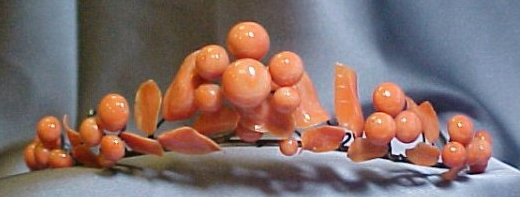
Now, it’s time to die. This pink diamond tiara, and those pinks come from the Australian mines at Argyle. No one knows what makes a diamond pink. Anyway, I’m dying. It’s listed for $192,732 (I think it will go for more) in Hong Kong for an Oct 7 sale. There is a fancy intense pink diamond in the middle, probably from the Argyle tender. It was made by Garrard, and is set on a platinum band.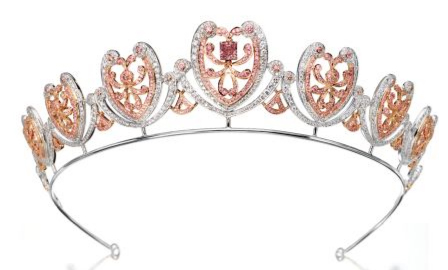
And here is a close up.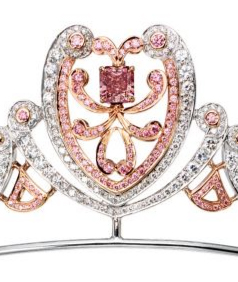
The pinks of Argyle (don’t let the size fool you), as well as the large D flawless white diamonds are nature at it’s most beautiful. It’s like a drug for diamond collectors and admirers. You just have to have it. I wonder who will buy this. I see it as Elizabeth Taylor-worthy.
The Comb, by Jen Cruse
Recently, as I was perusing the web for something magnificent, I found that Jen Cruse wrote an astonishingly educated book about the history of comb making. It talks about the comb making art from ancient cultures to the present. She includes the liturgical combs, which I’ve featured here, the French ivory H combs of the 14th century, as well as combs depicted in paintings, stained glass, and other materials. Her personal collection numbers 1500. Wow! You can get the book from Robert Hale Publishers.
This is the comb on the front cover, closeup. I’m going to guess this is a Chinese-made ivory comb for the Victorian market. If I’m wrong, please comment. But this is an absolutely drop-dead museum-piece comb.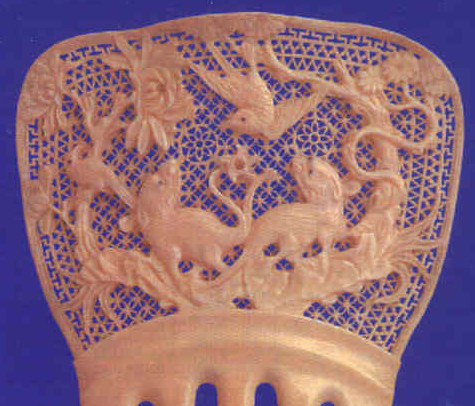
And here is the book cover.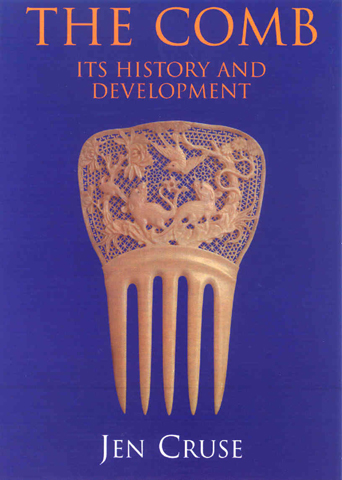
Japonisme and Myrna’s Turtle
It is a word used to describe the direct transfer of the genius of Japanese Edo artists, including comb makers, on French art nouveau artists of the 1900s. The French discovered Japanese art in 1856, and especially at the Paris Exposition Universelle of 1878. Many Japanese works of art were presented, and the craze of Japonisme began. To learn more, I recommend lotusgreen’s Japonisme blog.
I have seen many French combs influenced by Japanese artists, most notably Lalique’s horn Japanese landscape comb that sold for $237,000, but this is the first time I have seen a Japanese comb influenced by the French philosophy of Symbolism, one thing transforming into another, as a turtle comes out of the sea. This is Japonisme starting from the other direction.
The comb was bought for $350 at a live auction by Myrna, whose eye is untouchable, and it is made by a Japanese artist in blond tortoiseshell, with an image on the tines of algae clinging to the turtle’s shell underneath the water. 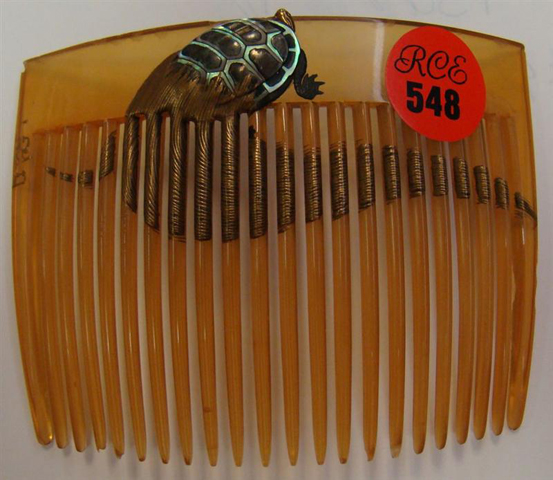
The other comb Myrna bought was an Edo ivory kushi decorated with paulownia flowers, which are native to China, northern Laos, and Vietnam, but cultivated in Japan. This comb sold for the ridiculously low price of $120 on August 19 at the same live auction.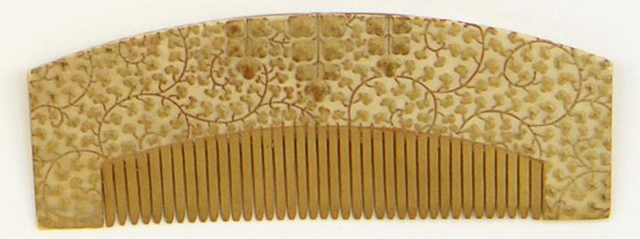
And this is what the real flower looks like: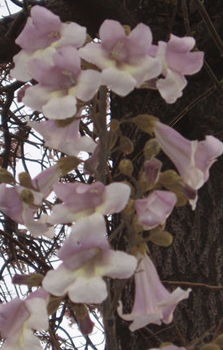
Myrna just emailed me some closeups because her treasures arrived.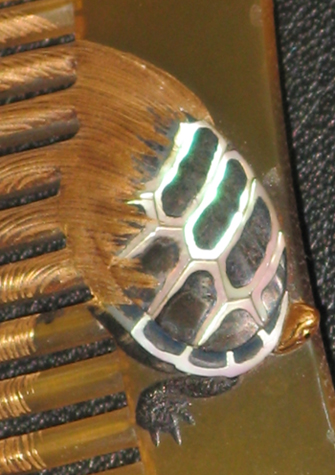
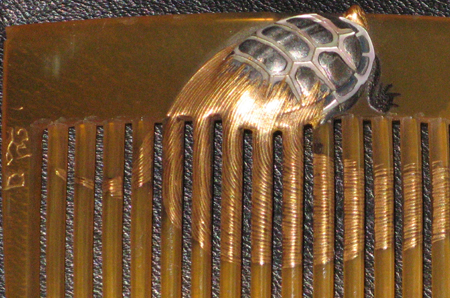
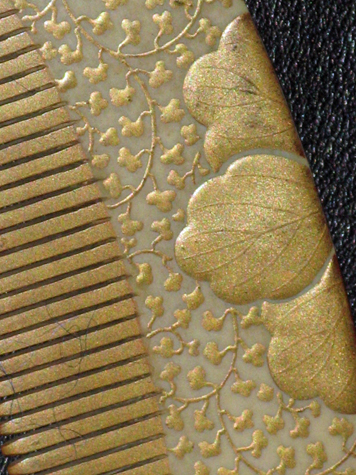
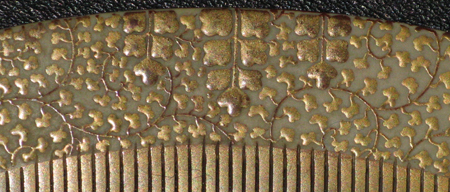
Both of them are just out of this world.
Some Lovely Things on Ebay
This beautiful ivory comb belonged to the seller’s great grandmother, and it was kept in perfect condition all these years. Imagine the love that kept this beautiful piece in its pristine state. The style looks like a Chinese import to the Victorian market to me but I’m not sure. Maybe it’s European made. Comments welcome. I loved it. It sold for $213.50 to Belva, one of the greatest hair comb collectors and historians in the country. Congrats, my dear friend.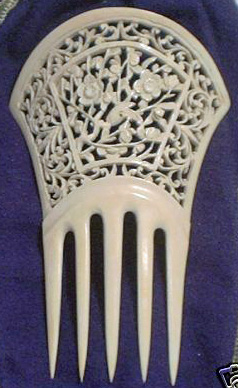
This ivory comb knocked me out. I’d say c. 1880. The rose carvings are exquisite. I adored this one, too. I have to say I am not sure if it’s English made or Chinese made for the Victorian market. But fabulous, nonetheless. It sold for $280 on August 9.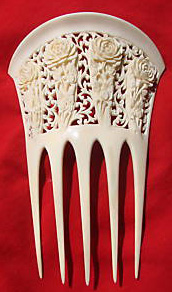
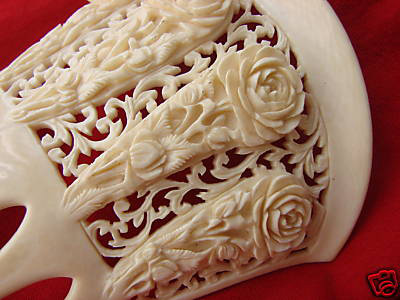
The last comb that caught my eye was an Silver Edo comb with a remarkable decoration of birds on the sides and a turtle in the middle against a backdrop of flowing waves. The silver decorative shell fit over a tortoiseshell comb, which was not in perfect condition, as the tines were a little damaged. But this was a drop-dead piece for Japanese comb collectors. It sold for $301 on August 10 to Belva. Congratulations again for your taste and everything you’ve done to bring the beauty of hair combs to the world via the ACCCI.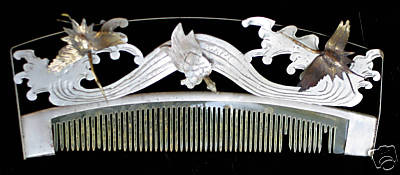
My Treasure Arrived
My treasured Chinese ivory comb made it to my glass collection box. It moves me utterly. 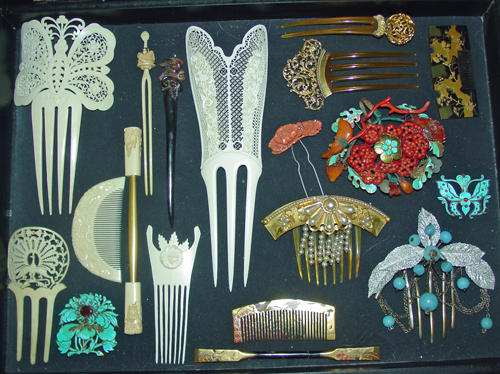
Some Lovely Things on Ebay
There were five combs that caught my attention, one of which I bought. A “friend” ;-) castigated me for my greed and obsession, but she’s right. Collecting Maltese Falcons is war, within yourself and with your competitors. I lost the war within myself on this comb. But when you collect, so much of your naked identity goes into what you choose. That’s why it’s always interesting to see other people’s full collections. They are reflections of identity a social face cannot hide. Anyway, here they are:
The Chinese made these types of combs for the English export market in Victorian times. Ivory is perfect, carving is gorgeous, no flaws, my mind exploded. I bought it for $500, beating a snipe bid of $495. I’d love to know who the other bidders were. You may refer to auction #350082094072.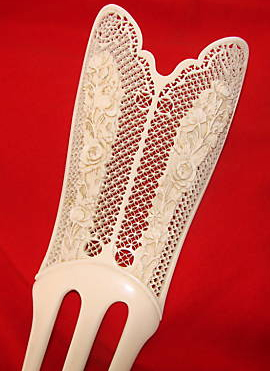
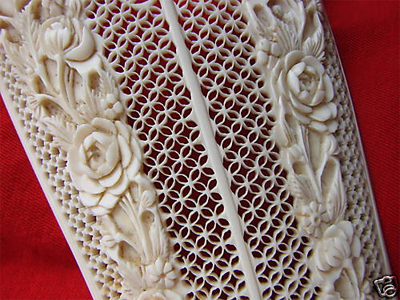
This magnificent tortoiseshell comb was one of two (the other one was bleh) that went for a total of $80 on July 27 at a live auction. $40 for this? Spell Bargain. It was won by a live floor bidder. They were valued at $200 – $300. You may refer to auction #140244906799. 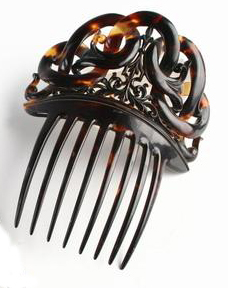
This lovely art deco comb went for $99.95 on July 20. I adore it. Congrats to the winner. You may refer to auction #200238922080.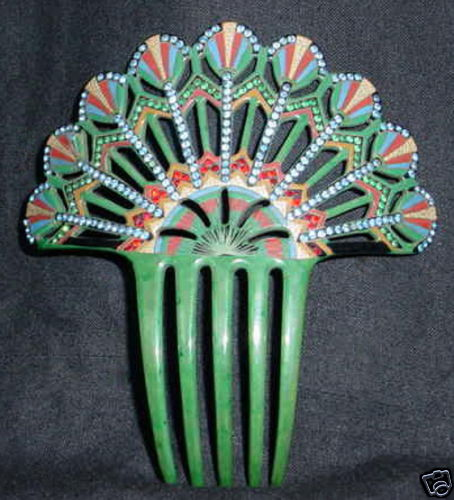
A beautiful ivory comb with floral decoration went for $327 on July 23. You may refer to auction #290245775831.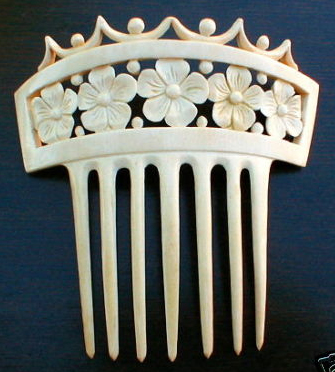
Finally, I very much liked this celluloid, what they call French Ivory, comb. It has a beautiful butterfly design and the identifying French-style 5 tines of the comb. It went for $42 on July 18. You may refer to auction #220255014546.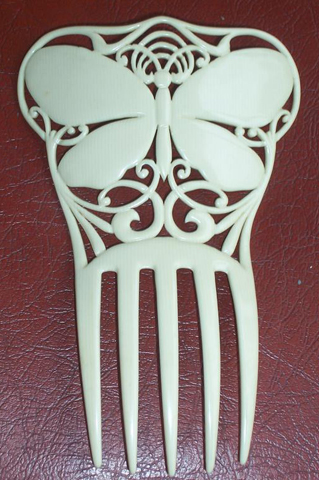
Happy Collecting!
Ancient British Comb found in Wales
The British Museum, where this comb resides, thinks that because it is made of rare elephant ivory, it must have been used in a religious ceremony consecrating a Bishop. The comb dates back to the 11th Century AD and was found in Wales. It is carved on both sides, but the inscription cannot be deciphered. The siginificance of the figures is also not known, although one is armed, and one takes a submissive position. During the 12th Century, religious combs were made of walrus tusk. That this is elephant ivory makes this extremely rare. In fact, no other piece of ivory is known to have survived from this period in Britain.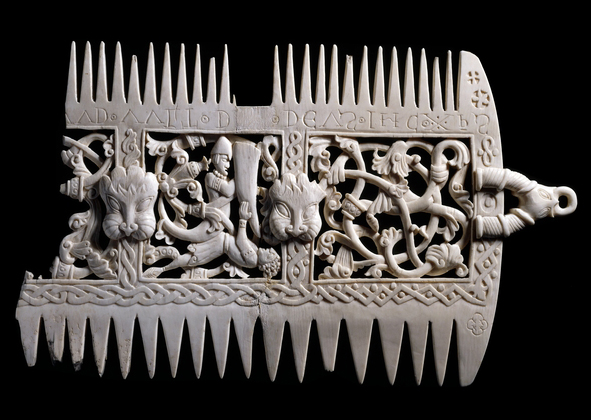
At Christies…
There have been some wonderful things sold. Here are my picks.
c. 1890, blond tortoiseshell hair pin with gold openwork, decorated with leaves and diamond accents. Sold at $1042.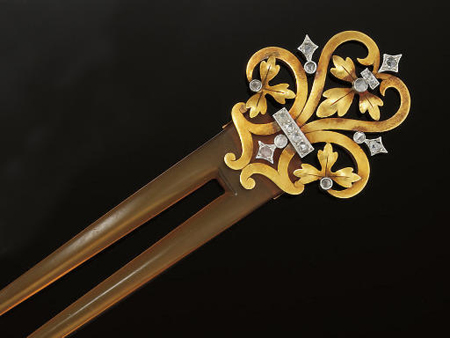
A diamond brooch with open work foliate spray, centered around pear-shaped diamonds, comes with a tortoiseshell comb. This continues the tradition that a beautiful piece of jewelry was used for many purposes. Sale price: $145,000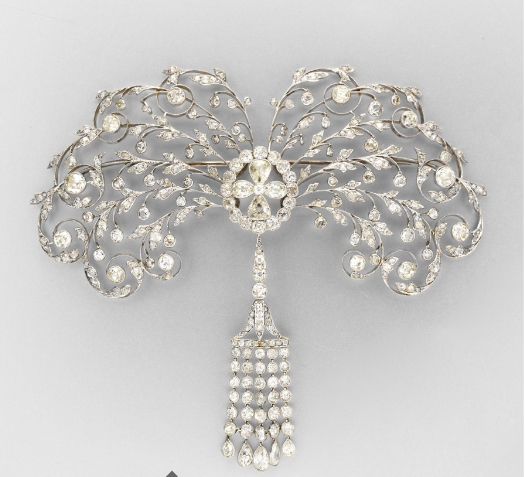
This set of rose-cut diamond and tortoiseshell hair combs, with this fabulous art nouveau silver comb sold for $1775.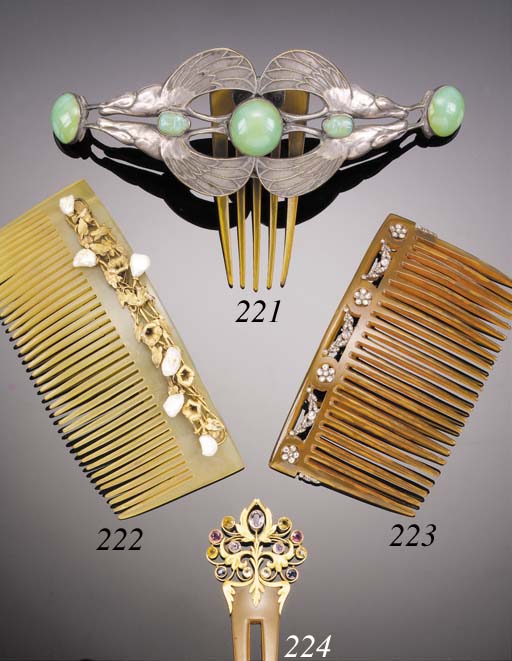
This cameo panel shows Aurora preceeding the chariot of Apollo. It was copied from the work of Guido Reni for the ceiling of the garden pavilion of Palazzo Rospigliosi, Rome. The mount is silver with an engraved decoration to the base, attached to a hair comb fitting. Sale price: $1566.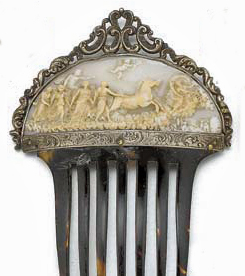
An art nouveau comb in bone, horn and sapphire cabachons by Lalique, where the women’s arms are elongated into wings sold for $32,449.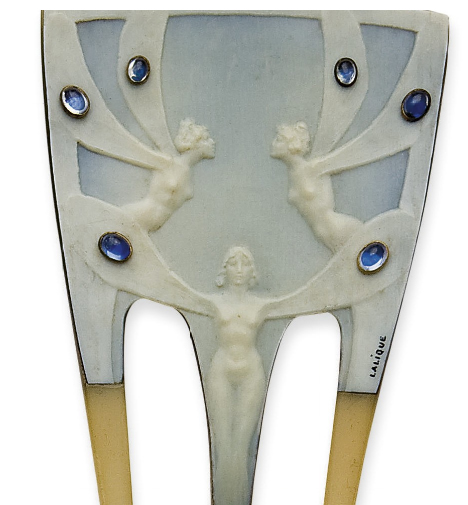
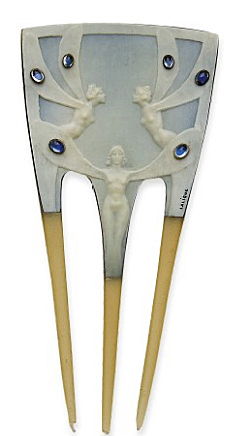
This beautiful gold Victorian parure is complete, with the necklace, bracelets, earrings, brooch, and diadem hair comb. The comb has 11 graduated floral ornaments in three colors of gold. Sale price: $14,264.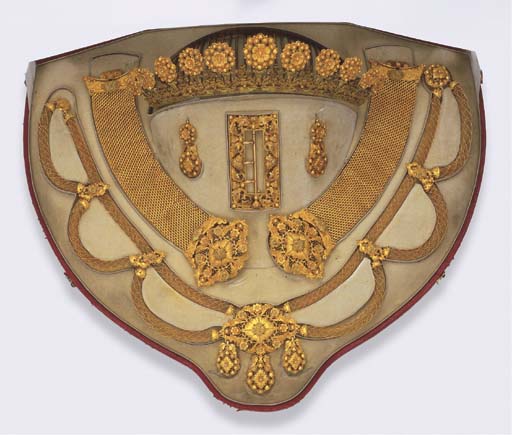
Finally, this baroque pearl, diamond, and enamel hair pin on tortoiseshell tines. Mounted in silver and gold. Sale price: $10,777.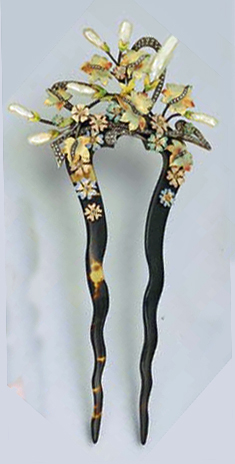
At Sotheby’s
There is a pair of tortoiseshell opera combs with a horseshoe-shaped openwork floral design, est. 4000 – 6000 UKP, which will go on sale July 22. c. 1910.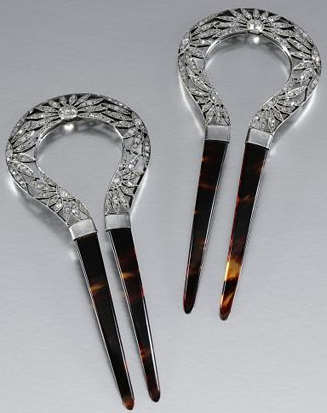
There are also two diadem ornaments c. 1800 with seed pearls and gold, acanthus leaves and flowers, beautifully detailed est. 3500 UKP, also going on sale July 22 in London. Some of the seed pearls are missing.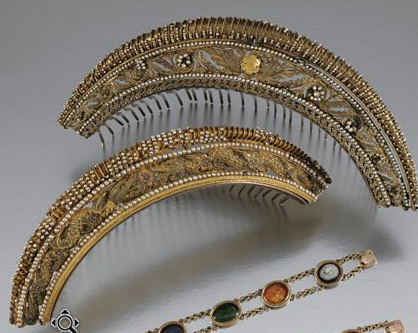
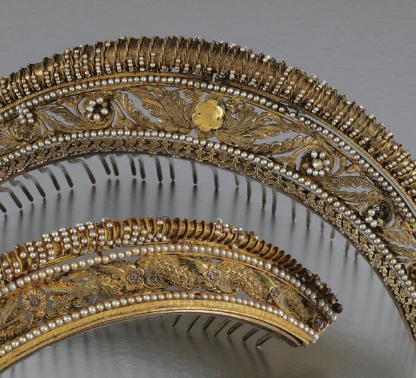
This beautiful ornament used to have tortoiseshell tines. I guess one could put them back on again in a repair. c. 1915.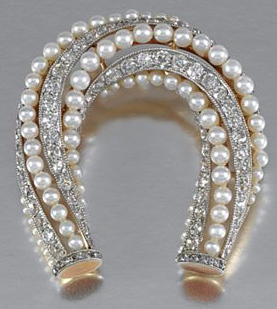
And finally, a diamond tiara. It has 5 star jewels. People used to take the jewels off tiaras and use them for other things. A tiara was a multiple-use object. This piece is accompanied by 2 tiara fittings, 5 hair pins, 5 brooch fittings, and one tortoiseshell hair comb. est. 8000 – 12000 UKP.